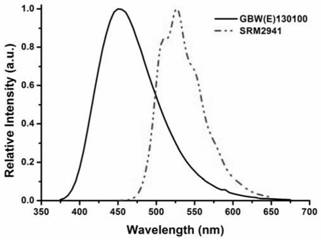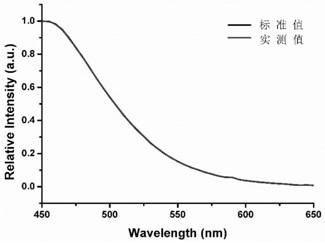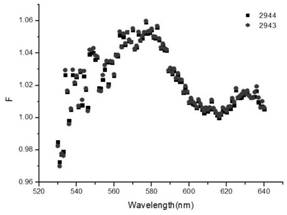DPA solution relative fluorescence emission intensity standard substance and its preparation method and application
A technology of emission intensity and standard substance, applied in fluorescence/phosphorescence, material excitation analysis, material analysis by optical means, etc., to achieve the effect of stable measurement method
- Summary
- Abstract
- Description
- Claims
- Application Information
AI Technical Summary
Problems solved by technology
Method used
Image
Examples
Embodiment 1
[0068] The development of embodiment 1DPA o-xylene solution relative fluorescence emission intensity standard substance
[0069] 1. Standard material sample preparation
[0070] 1.1 Raw materials and reagents
[0071] Raw materials: Commercially purchased high-purity ethyl 6-[4-(diphenylamino)phenyl]coumarin-3-carboxylate, purchased from TCI Chemical Industry Development Co., Ltd. (TCI), 1 bottle.
[0072] Solvent: chromatographically pure o-xylene (CAS: 95-47-6), purchased from Fisher Co., Ltd., in a 4 L package.
[0073] 1.2 Equipment
[0074] 1.2.1 Equipment for standard substance preparation: 2000mL grade A volumetric flask; balance with accuracy of 1 / 100,000 (Sartorius, Germany); electric pipette (Eppendorf, Germany); class 100 clean bench, etc. Passed the test.
[0075] 1.2.2 Standard substance packaging equipment: 5mL brown ampoule bottle and ampoule melting and sealing machine and other equipment.
[0076] 1.2.3 Equipment for standard substance analysis:
[0077]...
Embodiment 2
[0284] Embodiment 2 DPA o-xylene solution relative fluorescence emission intensity standard substance is aimed at the use result of different instrument parts
[0285] Referring to the standard material development process of NIST’s SRM2944, fluorescent standard materials should also be considered when using ① the position of the incident excitation light irradiated on the sample changes, resulting in uncertainty introduced by changes in absorption and inner filter effects; ② the incident and exit grating slits Uncertainty introduced; ③Uncertainty introduced by instrument components such as light sources, reflectors, and detectors; ④Uncertainty introduced due to light anisotropy and polarization of standard substances.
[0286] 1.1 The position change of incident light and the influence of light anisotropy
[0287] When investigating the first and fourth factors, since the DPA o-xylene solution is uniform relative to the fluorescent emission intensity standard substance soluti...
Embodiment 3
[0296] Example 3 Similar Standard Substance Quantity Comparison Verification
[0297] Use respectively:
[0298] 1. The SRM2941 standard substance of NIST (the selection reason is because the scope of its emission wavelength is basically consistent with the DPA o-xylene solution relative fluorescence emission intensity standard substance, and the size is the same during measurement) and the relative fluorescence of the DPA o-xylene solution prepared in Example 1 Emission intensity standard substances were compared for analysis.
[0299] 2. GBW (E) 130100 quinine sulfate fluorescent standard substance (the selection reason is because the scope of its emission wavelength overlaps with three kinds of relative fluorescence emission intensity standard substances, and both are in liquid form) and the DPA ortho-2 prepared in Example 1 The toluene solution was compared and analyzed relative to the fluorescent emission intensity standard substance.
[0300] Use DPA o-xylene solution re...
PUM
| Property | Measurement | Unit |
|---|---|---|
| concentration | aaaaa | aaaaa |
| correlation coefficient | aaaaa | aaaaa |
Abstract
Description
Claims
Application Information
 Login to View More
Login to View More - R&D
- Intellectual Property
- Life Sciences
- Materials
- Tech Scout
- Unparalleled Data Quality
- Higher Quality Content
- 60% Fewer Hallucinations
Browse by: Latest US Patents, China's latest patents, Technical Efficacy Thesaurus, Application Domain, Technology Topic, Popular Technical Reports.
© 2025 PatSnap. All rights reserved.Legal|Privacy policy|Modern Slavery Act Transparency Statement|Sitemap|About US| Contact US: help@patsnap.com



